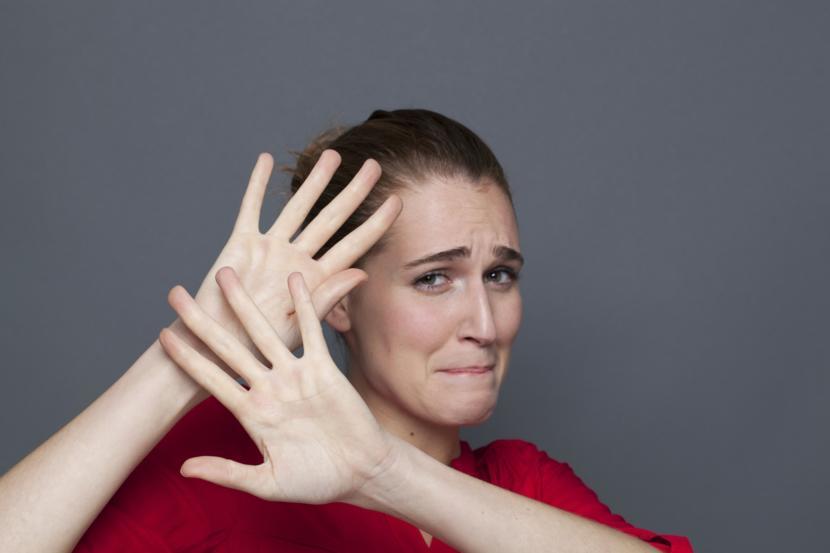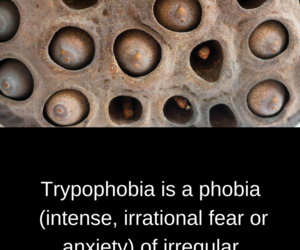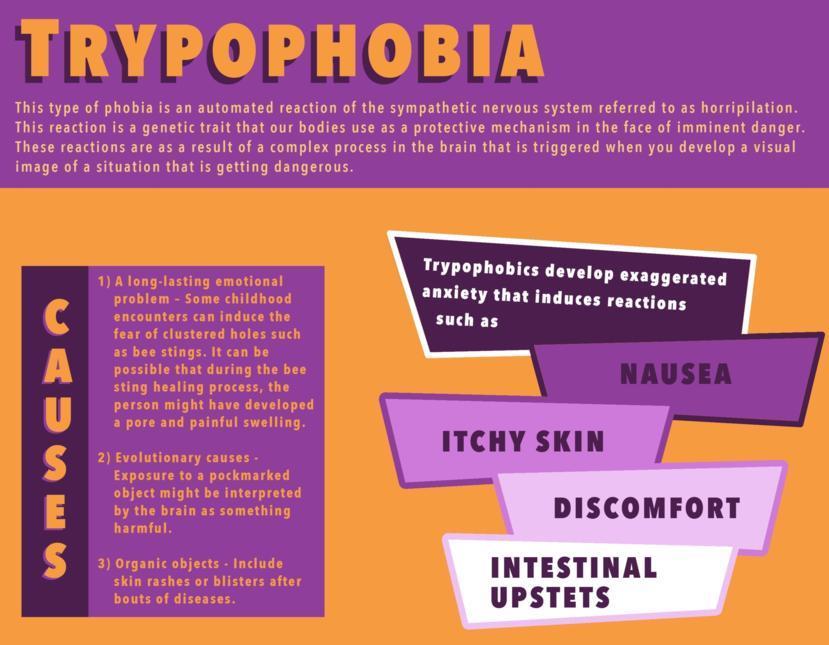Trypophobia and Other Strange Phobias

A phobia can be defined as a debilitating and overwhelming fear of a situation, object, animal, feeling, or place. Phobias are more evident compared to "fear" and normally occur when an individual has an unrealistic or exaggerated sense of danger about an object or situation. In case a phobia gets very serious, the suffering individual may plan their life so that they avoid the things that can cause them distress.
In trypophobia, certain individuals say that they start to panic or feel sick when they see holes or bumps that are in one place.
Phobia symptoms
The usual symptoms that are linked with phobia include the following:
- Nausea
- Breathlessness
- Trembling, dizziness, and a faster heart rate
- Fear of death
- Sense of unreality
- Obsession with the feared object
1) Trypophobia
Trypophobia is described as the "fear of clustered holes" or "tiny holes" found in organic objects such as batter bubbles or lotus seed heads. Seeing these things gives trypophobics intense fright, causing reactions such as nausea, itchy skin, and an overall feeling of discomfort.
According to research, approximately 15 percent of individuals get viscerally disturbed after seeing images of bumps or holes that are together.
Clustered holes are mostly found in:
- Soap bubbles and honeycombs
- Holes in plants such as corn, bean pods, and seeds
- Geological holes that occur naturally like rocks with uneven holes from the ocean
- Holes that are created by living organisms such as caterpillars, worms, and larvae
Although trypophobia is known as the "fear of holes", researchers have concluded that it is not only a fear of holes after looking more into it. The psychological community does not even recognize this type of phobia. Moreover, for many, it is not considered as a true phobia in the diagnosable sense.
According to research, trypophobia is more similar to "disgust" compared to "fear". The disgust is an overgeneralization of a response to potential irregularities. The disgust comes from object clusters and they may not always be "holes".
In case an individual suffering from trypophobia sees the images that can cause disgust, there is a rise in their heart rate and it gets more variable. Also, a section of their brain activity pierces the normal process of their vision.
What causes trypophobia?
What actually causes this bizarre condition is still not clear, but it is believed that trypophobia begins developing during childhood and goes on into the teenage years as it slowly clears away. This condition happens due to some internal and external predispositions or certain traumatic events that occurred during a person’s early life.
The majority of phobias develop spontaneously and for unknown reasons. Although some of them are psychological, hereditary, age-related, and culture-related.
Trypophobia emerges due to cultural factors, phenomena, as well as opinions from some national or group associations. Sometimes, trypophobia may develop in a specific social situation.
Trypophobia symptoms
A person with trypophobia typically experiences itchiness or uneasiness after seeing an object or substance that has many small holes like lotus seed pods, a sponge, anatomy of the bone marrow, or a wasp nest.
There are two distinct reactions that an individual with trypophobia may possibly show after looking at the holes:
- They may watch it for some time and then destroy or cover it.
- They may feel dizzy after seeing the holes.
Trypophobia treatment
Desensitization trypophobia is the most popular method used to treat the condition. It is the restoration of the usual mental and physical state of balance and harmony.
Psychological ways of replacement and correction can remove the obsessive fear of holes. A patient is showed a pacified image, which goes back to its normal state and later shown the picture with holes. This method is alternately conducted and is meant to alter the thinking of the patients, removing disgust, and restoring their peace of mind.
When necessary, the patient may be given sedatives during the treatment of trypophobia. A patient may be assigned a number of methods to relieve the symptoms of trypophobia. The doctor may advise the patient to do daily soothing, relaxing, and breathing exercises.
When a person has severe trypophobia where they experience convulsions, spasms, paralysis, severe headaches, and unconsciousness, they are treated with anti-inflammatory drugs, sedatives, and anticonvulsants.
2) Turophobia
Turophobia is described as the "fear of cheese". Those who experience this type of phobia normally keep off foods that contain cheese such as pizza with lots of cheese toppings. Individuals normally fear cheese due to their sticky appearance and cheesy taste. People with turophobia have a hard time coming close to cheese and may have a cold sweat after seeing it. Certain turophobes even fear of hearing the terms "cheesy", "cheese-flavored", and other words that are related to cheese.
Individuals with turophobia normally link cheese with a disturbing memory. No matter the type of cheese, turophobes run away at the sight of cheese.
3) Somniphobia
This type of phobia is defined as the "fear of sleep", which includes frequent, excessive, and irrational fear of sleep. Individuals with this condition are afraid of sleeping since they link sleeping to death. Somniphobia may also come from a continuous bout of nightmares. Some individuals are also afraid of losing time when they are asleep.
Symptoms of somniphobia
Just like any other phobia, symptoms may vary to individuals depending on their fear levels. Normally, the symptoms include "dread" and those that are linked to panic attacks such as rapid breathing, shortness of breath, irregular heartbeat, nausea, excessive sweating, shaking, dry mouth, and incoherence.
How to overcome somniphobia
1) Adopt a sleeping pattern
Come up with a routine or pattern for your sleep. Following a certain routine is important since your body will know when it is time to go to sleep.
2) Make the bedroom a good place to sleep in
It is important that you have good sleep hygiene practices. You should not put a television inside your room or make your room as your office or working area.
3) Know if it is somniphobia or insomnia
Individuals suffering from insomnia are not scared of sleeping but have problems falling asleep.
4) Coulrophobia
Coulrophobia is the fear of clowns and it mostly occurs in children. It is also a common type of phobia according to research. In popular culture, the scary clown is most often used. Normally, clowns are meant to be funny and should cause laughter and amusement, and not horror. Bright colors, huge smiley faces, party tricks, and slapsticks are normally not linked to extreme fear. Although when put together to produce a clown, they mostly lead to the opposite of their real intention.
Coulrophobia symptoms
Although coulrophobia may seem silly, an individual with this condition may have serious panic attacks at the sight of clowns. Other coulrophobia symptoms include:
- Feeling of terror or dread
- Trembling
- Anxiety
- Irregular or rapid heartbeat
- Shortness of breath
Coulrophobia treatment
Exposure therapy is mostly used in treating coulrophobia. This therapy enables individuals with coulrophobia to gradually familiarize themselves with clowns. It starts by patients discussing their fears and possible roots. They are then shown videos or images that are linked to clowns. The ultimate goal is to make them feel comfortable in one room with a clown. This process enables people with coulrophobia to get proverbial with their fears and to eventually desensitize them.
5) Ombrophobia
Although there are many people who love rain and are fascinated by it, others just prefer to stay indoors and avoid getting wet. There are, however, certain individuals who are extremely afraid of rain.
Ombrophobia may be described as the persistent and abnormal fear of rain mostly as a result of a bad past experience. When left untreated, a person with ombrophobia may develop a very irrational fear of rain.
Ombrophobia symptoms
Mostly, the symptoms of ombrophobia are associated with an extreme fear of rain, which is similarly common to many anxiety disorders and panic attacks. A person suffering from this condition may experience the following symptoms at the sight of rain:
- Inability to speak or think clearly
- Dry mouth
- Fast heart rate
- Uncontrollable feelings of anxiety or panic
- Breathing difficulties
- Muscle tension or trembling
What causes ombrophobia?
There are many reasons as to why an individual may have an extreme fear of rain. Usually, ombrophobia is linked to the fear of sickness or disease. These individuals may have heard or been told when they were small that they will become sick if they went out when it is raining. This fear may show itself later in life and turn into a real phobia.
A traumatic experience may also lead to ombrophobia. The idea or sight of rain, in this case, may trigger that particular traumatic experience with the individual reliving the moment.
Ombrophobia treatment
Treatment may include group therapy, exposure therapy, or learning new breathing techniques to manage one's stress related to rain. It is important to choose the type of treatment that you will stick with and can be easily incorporated into your lifestyle.
6. Nomophobia
Many individuals with cell phones can attest to the fact that they had a disturbing sensation in their stomach when they lost their cell phones. While others will easily move on and get another phone, others will panic once they lose their cell phones. Nomophobia can be described as the extreme fear of losing a cell phone and having a bad network coverage. This phobia may cause side effects such as shortness of breath, rapid heart rate, dizziness, panic attack, nausea, trembling, chest pain, and sweating.
Nomophobia symptoms
- An obsession with making sure that the mobile phone is within grasp.
- Constantly worrying about losing one's phone even when it is in a secure place.
- When the health of a person gets affected after the phobia has been going on for a long time.
Nomophobia treatment
There are many different methods for treating nomophobia such as exposure therapy or even medication in treating the most severe phobia. With exposure therapy, a person is slowly exposed to their phobia initially via the mind during therapy sessions and later in real-life situations. If you are scared of losing your phone, your therapist may require you to stay without it for a specific time. There are also possible personalized solutions.
Individuals with this condition may also use self-help methods in dealing with severe symptoms. The first step in treating nomophobia is to be informed regarding the condition. Since negative thoughts can lead to this type of phobia, it is important that you learn how to keep yourself from thinking about negative stuff. Severe phobia can also be treated using relaxation techniques such as yoga, muscle relaxation, and deep breathing.
7) Gynophobia
Gynophobia is defined as the "hatred" or "fear of women". Men normally suffer from this type of phobia. Gynophobia is also known as "feminophobia" or "gynephobia". Individuals with this condition fear women and are scared of having sexual relations with them. They may hate their mothers, sisters, or all women in general who are around them. Due to this phobia, certain gynophobics may put off marriage.
Caligynephobia or venustraphobia is a related phobia, which is known as the "fear of beautiful women".
Gynophobia symptoms
- Terror
- Panic
- Fast heart rate
- A dread feeling
What causes gynophobia?
Men who have this type of phobia may have gone through many different forms of traumatic experiences. They could have had a violent or sexual physical encounter with a woman probably when they were still young. They could also have witnessed a woman getting abused by a man. There are different levels of gynophobia outcomes depending on the phobia's roots and causes.
Normally, gynophobia develops in men who do not regularly interact with women. Individuals with this condition are unable to socially interact with women in normal life. Men with this phobia may also feel shy or have ill feelings toward women. Due to certain traumatic events, men may also feel lesser to women.
Gynophobia treatment
There are many treatment methods to overcome gynophobia. Reaching out to the doctor is the first step in the treatment process. The doctor may also refer you to a good mental health expert. It is important to make sure that you choose a treatment method that suits you best. Depending on your fear level, your mental health professional may prescribe different types of psychotherapy or counseling. Medication may be used in severe cases of gynophobia, although it might not completely cure your condition. You may use exposure therapy, behavioral therapy, and cognitive behavioral therapy.
8) Xanthophobia
This type of phobia is described as the fear of the word "yellow" or the yellow color itself. "Xantho" is a Greek word that means "yellow" and phobia means fear. Xanthophobia is normally termed as a specific phobia. This condition is similar to the fear of colors, which is called as "chromatophobia". The fear of color "white" is known as "leukophobia" and the fear of color "purple" is called as "porphyrophobia".
What causes xanthophobia?
It is a common fact that phobias normally come from a combination of traumatic events and genetics. The majority of particular phobias arise from a specific triggering experience, normally a traumatic event at a tender age. Agoraphobia and social phobias have more intricate sources that are still unclear. Moreover, brain chemistry, genetics, and hereditary factors combined with a person’s life experiences may lead to the occurrence of phobias.
Symptoms of xanthophobia
Just like any other phobia, the symptoms of xanthophobia may be different depending on an individual’s fear level. Normally, the symptoms include intense anxiety, shortness of breath, sweating, nausea, incoherence, shaking, dry mouth, fast breathing, and an abnormal heartbeat.
Treatment for xanthophobia
Although medicine may be recommended, it is important to understand that xanthophobia medications have withdrawal symptoms or severe side effects. You should also note that these drugs are not effective at treating phobias and that they only suppress the phobias temporarily.
9) Melophobia
Music usually goes beyond cultural and language barriers in issues concerning the heart. Most of the time, music is known to calm a person and may make an individual to remember a particular place and time in the past that ties them to the music. The type of music that we often listen to can in a way become part of us.
Melophobia is defined as the "fear of music". Some people may experience fear and anxiety after listening to music. Personal connection to music that causes fear and negative emotions is the primary source of melophobia.
Some of the symptoms that are associated with melophobia are as follows:
- Shortness of breath
- Nausea
- Weeping
- Fast heart rate
- Panic attack
- Dizziness
- Screaming
- Fleeing
- Trembling
- Incoherence
- Loss of control
A person suffering from this phobia may either play very few music or fail to play at all. People who have melophobia may find it hard to socially interact with other people in places such as offices and stores, where music is constantly played.
Individuals with melophobia may sometimes even experience "death anxiety" when they learn that the songs they are listening to have lyrics concerning death.
The method of treatment for melophobia is through learning that music does not have an unpleasant effect on upcoming life experiences. The individual is then advised to distinguish the types of music that can trigger negative or positive emotions. Listening to gentle and soft music may even be an effective method for treating melophobia. Other melophobia treatments include NLP (neuro-linguistic programming), hypnotherapy, and energy psychology.














